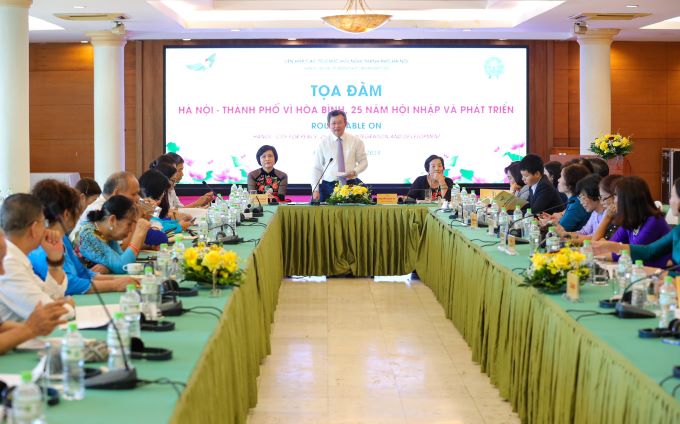HANOI - THE CITY FOR PEACE

Twenty-five years ago, on July 16, 1999, Hanoi became the first city in the Asia-Pacific region to be honored with the title “City for Peace” by UNESCO. This recognition by the international community acknowledges the cultural traditions, peaceful nature, and deep-seated desire for peace of the Vietnamese people. It also highlights the achievements of Hanoi, the capital city, in its journey of renewal.
A quarter of a century has passed, and Hanoi remains the only capital in the Asia-Pacific region to receive this prestigious title. This is both an honor and a significant challenge for Hanoi to continuously strive for enduring peace on Earth, which serves as a solid foundation for prosperous development and integration.
To meaningfully celebrate this important event, the Hanoi Union of Friendship Organizations is hosting a seminar titled “Hanoi - City for Peace, 25 Years of Integration and Development.” The seminar aims to review the achievements made since Hanoi was honored by UNESCO as a “City for Peace,” based on five groups of criteria: (1) exemplary actions in equality, social cohesion, and community dialogue promotion; (2) modern urban development while preserving identity and memory; (3) environmental preservation; (4) cultural development promotion; and (5) exemplary education, particularly in civic education and youth development. The program provides an opportunity to promote Hanoi’s culture and people and ignite the pride of the capital’s citizens in the City for Peace. It also aims to collectively build, preserve, and enhance the value of the City for Peace title, striving towards a peaceful, prosperous, and happy world.
The organizing committee received 12 papers from leaders, managers, scientists, ambassadors, international friends, and various social classes, all expressing their love for Hanoi. These papers were prepared with great dedication, covering the historical process of Hanoi’s application for the UNESCO “City for Peace” award to the impressions of international friends about the over-thousand-year-old capital. Adhering to five core content pillars, the papers focus on five prominent highlights:
- Theoretical Perspective: The Central External Relations Commission’s paper provides a comprehensive overview and orientation for the seminar, titled “The Party’s Perspective on Promoting Vietnam’s Peace and Friendship Values in the Current Context.” It highlighted Ho Chi Minh’s thoughts on peace and friendship and the Party’s views on these values.
- Social Movement Perspective: Dr. Dao Quyen Truong, Deputy Director of the Department of Cultural Diplomacy and UNESCO, Ministry of Foreign Affairs, emphasized that “Promoting UNESCO titles is a long journey requiring perseverance, effort, and creativity from the entire society. It involves the collaboration of the political system, citizens, and the business community.” The peace-loving movement and the honor of the City for Peace title were vividly expressed in the impressive paper by the Hanoi Youth Union. By promoting the pioneering and creative role, the “I Love Hanoi” movement has been actively advanced by the capital’s youth, creating many practical imprints. Recently, the youth of the capital have marked their presence with the “Green Zone in Cyberspace” model - 579 community groups at the commune level on Facebook.
- Practical Achievements: The outstanding achievements of 25 years of integration and development of the capital are clearly reflected in four papers from the Departments of Culture and Sports, Tourism, Natural Resources and Environment, and the People’s Committee of Hoan Kiem District. These papers evaluate Hanoi’s efforts in maintaining UNESCO’s required criteria: equality and cohesion in the community; sustainable urban development management; environmental protection; cultural development promotion and urban memory; and civic education and youth care. The City for Peace title has motivated the city to develop and contribute by promoting heritage values and building city symbols.
- Cultural and Heritage Values: It is essential to further promote the unique cultural and heritage values of the capital. Mentioning Hanoi inevitably brings up the East-West cultural encounter. Hanoi is a city of diversity, with a dense concentration of historical sites, rich cultural heritage, and a vast array of cultural assets. Hanoi has become a nurturing ground for creativity, with creative designs present in every corner of the city, from urban infrastructure with “multi-layered historical” architecture to diverse and rich cultural infrastructure, contributing to harmonious connections in life between nature and humans.
- Leadership and Direction: The Hanoi Union of Friendship Organizations will thoroughly implement the guidance of the Central External Relations Commission: “The Hanoi Union of Friendship Organizations needs to build a comprehensive strategy, program, and specific action plans. This involves mobilizing diverse forces and utilizing all forms and tools of diplomacy across various fields to effectively fulfill the foreign affairs tasks and objectives of the capital and people's diplomacy in general. This includes promoting cooperation and exchange activities to educate and raise awareness among the people, especially the younger generation, about the values of peace and friendship in the current context. It also involves enhancing international cooperation activities to overcome and heal the consequences of war, increasing the mobilization of international and foreign resources for socio-economic development, and strengthening external information and communication work.” It is time for Hanoi to have an action program to promote the value of the City for Peace title, focusing on leadership and direction while contributing to renewing the content and methods of people’s diplomacy in the capital.
The papers have been compiled into a bilingual seminar proceedings book in Vietnamese and English, presented to the seminar participants and some foreign diplomats working in Hanoi.
Ngoc Khanh